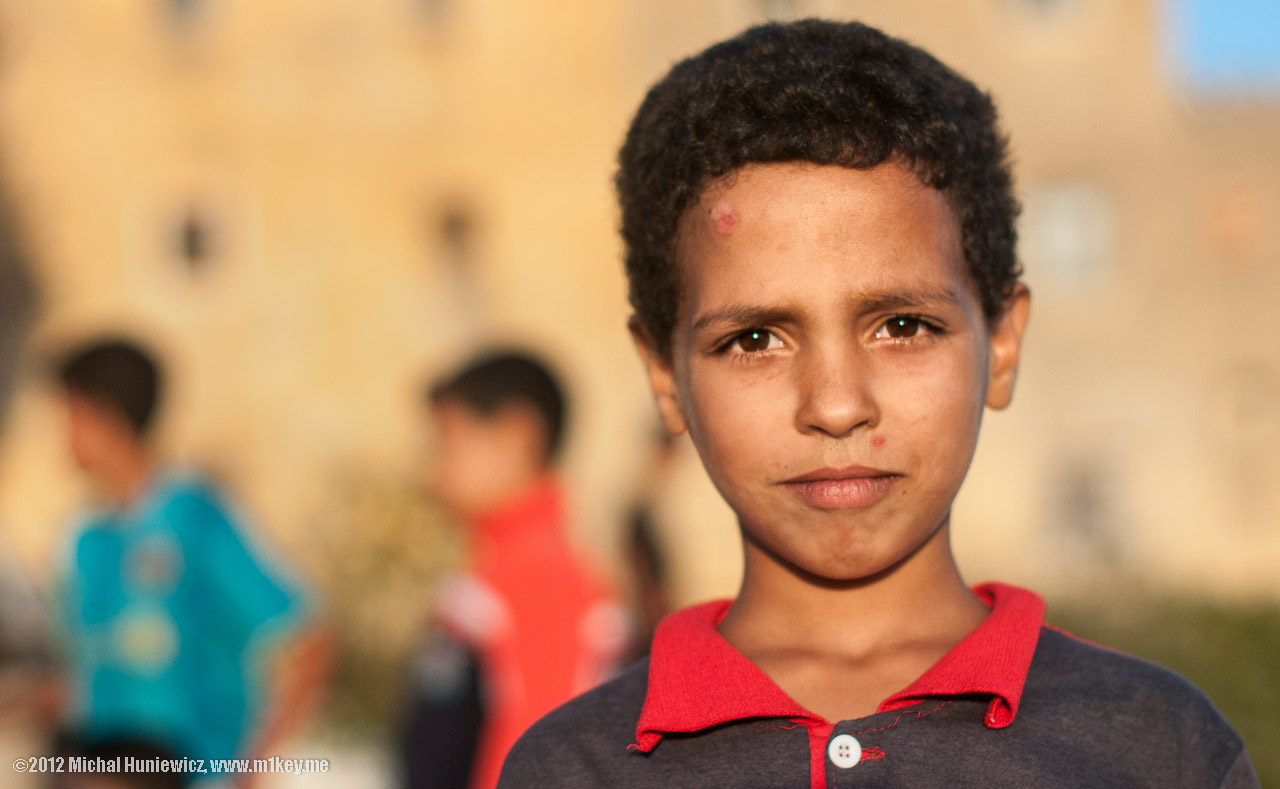Fez, Morocco Photography - M1key - Michal Huniewicz

These are my pictures I took during my trip to Fez, Morocco (alternative spelling: Fes), in September 2012. It was a bit of a bad luck trip; from Muslim riots raging across North Africa and the Middle East, to delayed flights, to exploding yoghurts; but nevertheless I think I managed to capture some interesting shots.
The Fez medina (old town in a North African city) is the largest medieval medina in the world! Fez was the capital of Morocco until 1912, when this role was given to the city of Rabat. [8]
This is my first gallery to include technical information about the shots, for your benefit, hopefully.
Thanks to Aicha (captions)!
Medina

This is the Fez medina, as seen from a hill north of the city. The medina is 1200 years old!
The minaret on the left hand-side is that of Zaouia Moulay Idriss II, the shrine of Moulay Idriss II, whose father founded Fez in 789. [3] The one in the centre is R'Cif mosque. [4] [5]
The minaret on the left hand-side is that of Zaouia Moulay Idriss II, the shrine of Moulay Idriss II, whose father founded Fez in 789. [3] The one in the centre is R'Cif mosque. [4] [5]
ISO 200, 75 mm, f/11, 1/125 s.
Blue Gate

This is Bab Boujeloud, or the Blue Gate, built in 1913. [2, p.166] It is highly decorated, because gates were no
longer seen as a part of defence systems, with the dawn of modern warfare.
Bou Inania Medersa and Abou El-Hassan minarets visible through the gate. [5] Even before you enter this gate, you will be harassed by guides and false guides, and other people who desperately need to "relieve you of your money whose value you don't know", to quote an early 20th century English travel guide. [6, Preface]
Bou Inania Medersa and Abou El-Hassan minarets visible through the gate. [5] Even before you enter this gate, you will be harassed by guides and false guides, and other people who desperately need to "relieve you of your money whose value you don't know", to quote an early 20th century English travel guide. [6, Preface]
ISO 400, 32 mm, f/7.1, 1/1250 s.
Bou Inania Madrasa

The Bou Inania Madrasa was founded in 1351–56 by the Berber king Abu Inan Faris of the Merenid dynasty. [7] What is a madrasa?
The madrasa was an establishment with two roles: cultural and religious. It served as a university for local students, but it was open for those coming in search of knowledge from pretty much anywhere. It was also a place of prayer.
Sadly, most of the Fez madrasas are closed to non-Muslim visitors, as religious objects. You'd think they'd let you in the name of religion-agnostic science (after all, it was a university), but no. In this madrasa you can only see the courtyard and enter one empty room.
The madrasa was an establishment with two roles: cultural and religious. It served as a university for local students, but it was open for those coming in search of knowledge from pretty much anywhere. It was also a place of prayer.
Sadly, most of the Fez madrasas are closed to non-Muslim visitors, as religious objects. You'd think they'd let you in the name of religion-agnostic science (after all, it was a university), but no. In this madrasa you can only see the courtyard and enter one empty room.
ISO 200, 11 mm, f/2.8, 1/5000 s.
Wooden screen detail
Butcher
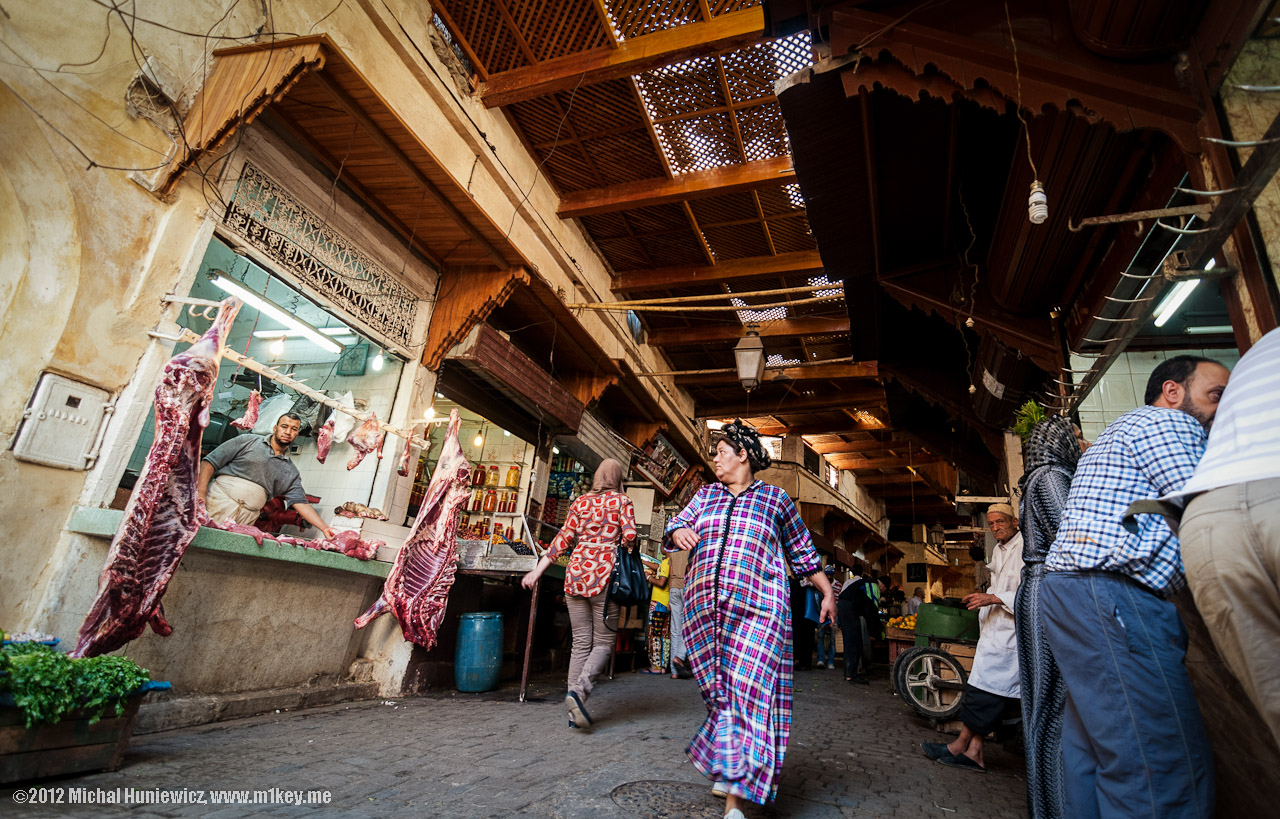
I'm looking at the woman, while she's looking at the butcher, while the butcher is looking at... me. Uh oh. Better
not take a picture of him!
ISO 200, 11 mm, f/2.8, 1/80 s.
Photography in Fez

But then what can he do other than frown.
People in the medina generally don't particularly like being photographed. As I was travelling with a group of photographers, we (7 people) discussed that a few times and two attitudes emerged. 1) Take a sneaky picture when they cannot see you. 2) Ask them and only shoot if they agree.
The first way allows you to take candid shots, and I did shoot a few of these, but somehow I preferred the second way. I approached a man with a sewing machine and asked him for a picture. He just shook his head. I offered some coins and he smiled with dignity and shook his head again. After that I didn't try bribing them into posing.
People in the medina generally don't particularly like being photographed. As I was travelling with a group of photographers, we (7 people) discussed that a few times and two attitudes emerged. 1) Take a sneaky picture when they cannot see you. 2) Ask them and only shoot if they agree.
The first way allows you to take candid shots, and I did shoot a few of these, but somehow I preferred the second way. I approached a man with a sewing machine and asked him for a picture. He just shook his head. I offered some coins and he smiled with dignity and shook his head again. After that I didn't try bribing them into posing.
ISO 200, 11 mm, f/2.8, 1/50 s.
Souk

Meat next to fruits, fruits next to clothes - welcome to the souk (or souq). It is a very lively place where
locals do their shopping, cats sleep and fight one another, and here and there you can find...
free wi-fi, that's right.
Souks, open-air marketplaces in an Arab or Berber city, entail the concept of free-market. Originally, they were held outside the cities, but then shifted inside, as urban centres became more important. I showed you an outside-city souk in my Bedouin gallery.
The Fez medina is UNESCO World Heritage site. [8]
Souks, open-air marketplaces in an Arab or Berber city, entail the concept of free-market. Originally, they were held outside the cities, but then shifted inside, as urban centres became more important. I showed you an outside-city souk in my Bedouin gallery.
The Fez medina is UNESCO World Heritage site. [8]
ISO 560, 11 mm, f/2.8, 1/125 s.
Minarets

Minarets.
Did you know that... The tallest minaret, at 210 metres is located at the Hassan II Mosque in Casablanca, Morocco? [9]
Did you know that... The tallest minaret, at 210 metres is located at the Hassan II Mosque in Casablanca, Morocco? [9]
ISO 200, 44 mm, f/7.1, 1/500 s.
Walls

These are the oldest ramparts of the medina, from the 12th century, built under the Almohads.
Throughout centuries Morocco was a part of different empires (e.g. Roman, Umayyad, French) that had no Moroccan nature to them. The Almohad Empire however was among the few at least party Moroccan ones.
But, can you see people sitting on the walls?
Throughout centuries Morocco was a part of different empires (e.g. Roman, Umayyad, French) that had no Moroccan nature to them. The Almohad Empire however was among the few at least party Moroccan ones.
But, can you see people sitting on the walls?
ISO 200, 65 mm, f/14, 1/100 s.
People

Here they are, on the left!
(This is a crop from the previous picture.)
(This is a crop from the previous picture.)
ISO 200, 65 mm, f/14, 1/100 s.
Jardins de Bou Jeloud
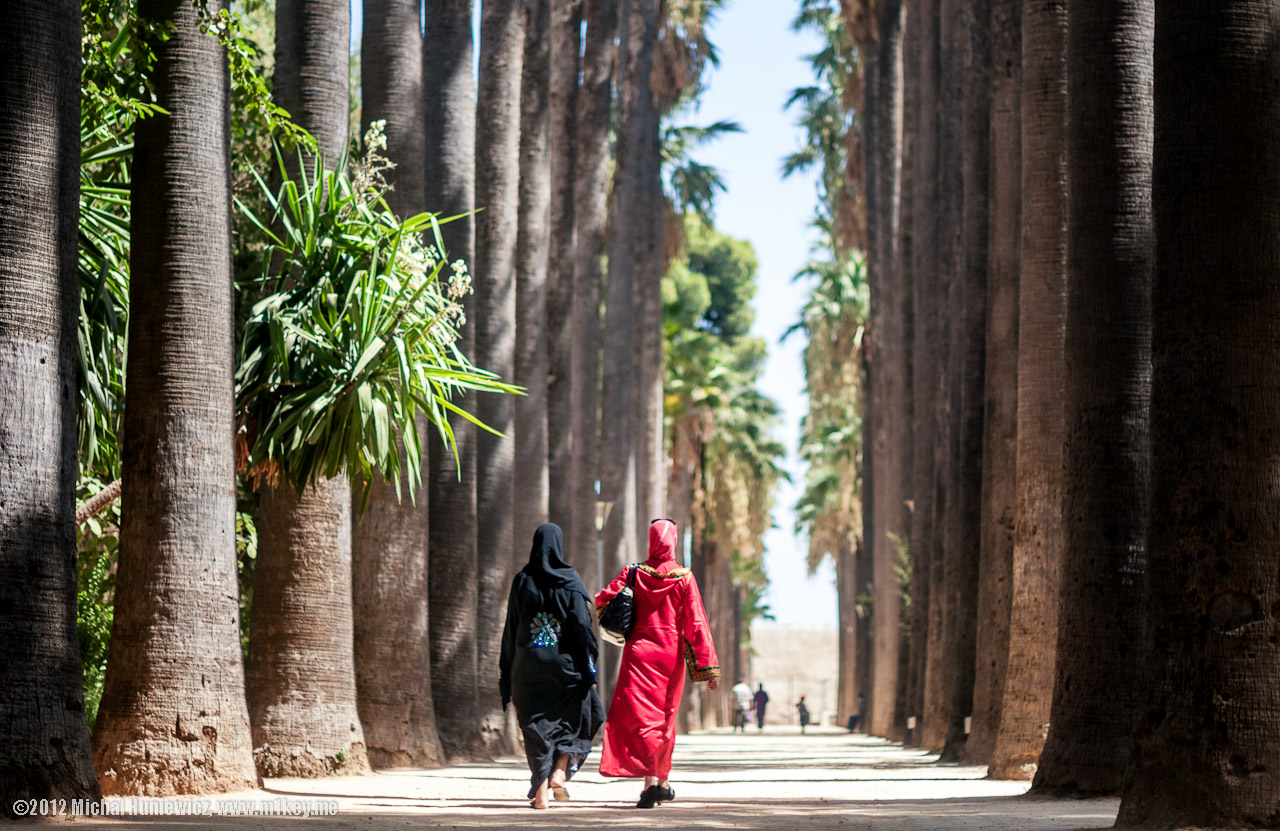
We're going now to the western side of the medina (the ladies are going the opposite way, unfortunately). These gardens
are inside the medina and within the walls.
ISO 200, 50 mm, f/1.4, 1/8000 s.
Busy street

This is a busy street in the western side of the medina. This part of the city was founded in the 13th century
and it does indeed feel less old than the eastern one. [8] It was founded by the Merenids, and they were a Moroccan
dinasty and empire as well; weak militarily, but great builders they were.
ISO 200, 38 mm, f/4.2, 1/1250 s.
Nice melons

Local men cheered when I was taking this picture. Generally, they feel quite territorial about "their" girls,
which they cannot have anyway, due to social restrictions. It happened to me in one Arab country that as I was hanging out with a local girl,
she was being insulted by grumpy old men for talking to a white guy. As a tourist I felt omnipotent and wanted to react,
but she asked me not to, as I was going away but she had to stay.
ISO 200, 46 mm, f/4.5, 1/640 s.
Market

This used to be a Jewish market, but the Jews are gone now (apparently, they have mostly gone to the US). From what I found out,
they used to live in Morocco in peace and harmony with the Muslims (better than with the Christians at least), most of the time,
being fairly well respected, but not really equal. There were, however, anti-Jewish terrorist attacks
in Morocco, in 2003.
In the same neighbourhood, there is a synagogue which the Moroccans take care off, that has been renovated thanks to private donors, and is no longer in use as such.
In the same neighbourhood, there is a synagogue which the Moroccans take care off, that has been renovated thanks to private donors, and is no longer in use as such.
ISO 900, 52 mm, f/8.0, 1/125 s.
Yummy
Blue

These buildings are supposed to be restored by UNESCO in 2013, from what I was told.
Blue is the colour of Fez.
Blue is the colour of Fez.
ISO 200, 18 mm, f/3.5, 1/6400 s.
Kids

The area we (from now on 'we' means 2 people, my friend Daniel and myself, as our group diverged into smaller ones)
entered was not one for tourists, really, and it was full of such poor-looking kids,
who asked us for money, which they didn't get. These two then asked me for my small bottle of water,
half-empty. For them it was apparently half-full; anyhow, I didn't mind them taking it.
ISO 360, 36 mm, f/4.2, 1/125 s.
Girl

I shot this from a roof-terrace of one of the private houses, where they let us in.
ISO 200, 65 mm, f/5.0, 1/6400 s.
Mosque

This picture and all the following are taken outside the medina. In the Middle East and North Africa,
if you want to meet real people who don't just think of ripping you off, you have to leave the tourist areas;
this, at least, is my experience. You'll find ordinary people who will be astonished to see you;
some will try to talk to you, others will be too shy.
This is the Mosque of Hamza ibn Abdul Muttalib, the Martyr, who was the paternal uncle of prophet Muhammad, and his foster-brother. [10] He was killed in the Battle of Uhud.
We were not allowed to enter the mosque; not here, not anywhere else in Morocco, which I found a bit odd after Tunisia, Crimea, Turkey...
This is the Mosque of Hamza ibn Abdul Muttalib, the Martyr, who was the paternal uncle of prophet Muhammad, and his foster-brother. [10] He was killed in the Battle of Uhud.
We were not allowed to enter the mosque; not here, not anywhere else in Morocco, which I found a bit odd after Tunisia, Crimea, Turkey...
ISO 200, 18 mm, f/3.5, 1/500 s.
Poor neighbourhood

One of the poor neighbourhoods, north of the medina, with narrow streets, densely packed with feeble-looking houses
and providing the refuge of shade.
ISO 200, 18 mm, f/5.6, 1/500 s.
Stadium

In this crater local people throw rubbish, while in the middle of it children are playing football.
ISO 450, 18 mm, f/5.6, 1/50 s.
Children
Girl #1
Boy #1
Boy #2
Boy #3
Boy #4

Boy #4.
These kids couldn't speak English, but were super-excited about us being there, and really friendly, happily posing for pictures.
These kids couldn't speak English, but were super-excited about us being there, and really friendly, happily posing for pictures.
ISO 200, 50 mm, f/3.5, 1/2500 s.
Girl #2
Moroccan home
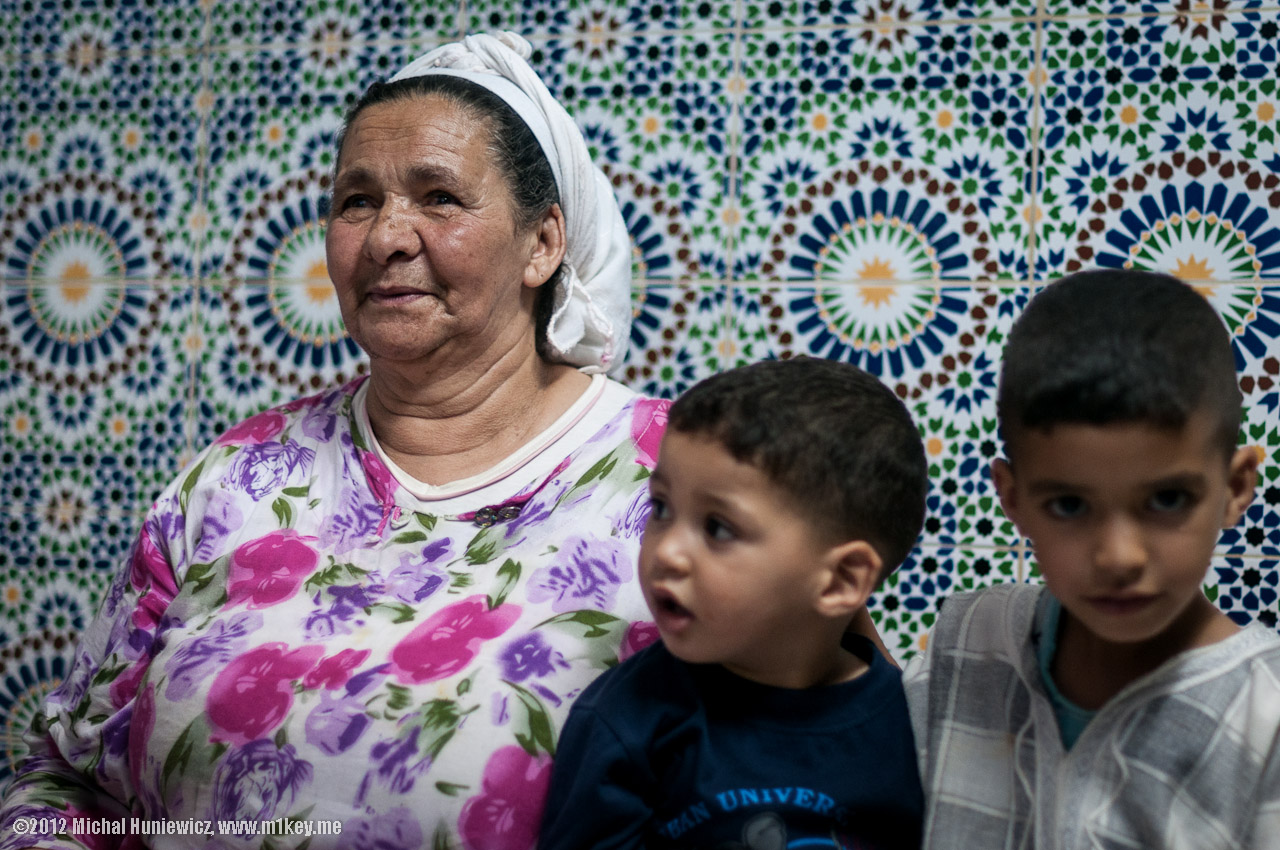
These people, too, let us inside their home. They gave us dinner and refused to be paid for it.
Moroccan homes such as this one seem to be built vertically rather than horizontally, meaning there are usually one or two rooms per floor, but many floors. The rooms are very dark and sometimes have no windows (this one didn't), the blue tiles making a rather cold impression, which I guess, is to be expected if not desired in Africa. Temperatures reached 35C when we were there and every day I would melt into an unrecognisable cross between a resigned zombie and a wet towel.
Moroccans have a sweet tooth, and most food that we were offered was incredibly sweet, drinks as well (such as the omnipresent mint tea). Sugar is probably used to preserve food.
I also burnt my hand with a teapot.
Moroccan homes such as this one seem to be built vertically rather than horizontally, meaning there are usually one or two rooms per floor, but many floors. The rooms are very dark and sometimes have no windows (this one didn't), the blue tiles making a rather cold impression, which I guess, is to be expected if not desired in Africa. Temperatures reached 35C when we were there and every day I would melt into an unrecognisable cross between a resigned zombie and a wet towel.
Moroccans have a sweet tooth, and most food that we were offered was incredibly sweet, drinks as well (such as the omnipresent mint tea). Sugar is probably used to preserve food.
I also burnt my hand with a teapot.
ISO 200, 50 mm, f/1.4, 1/80 s.
At home
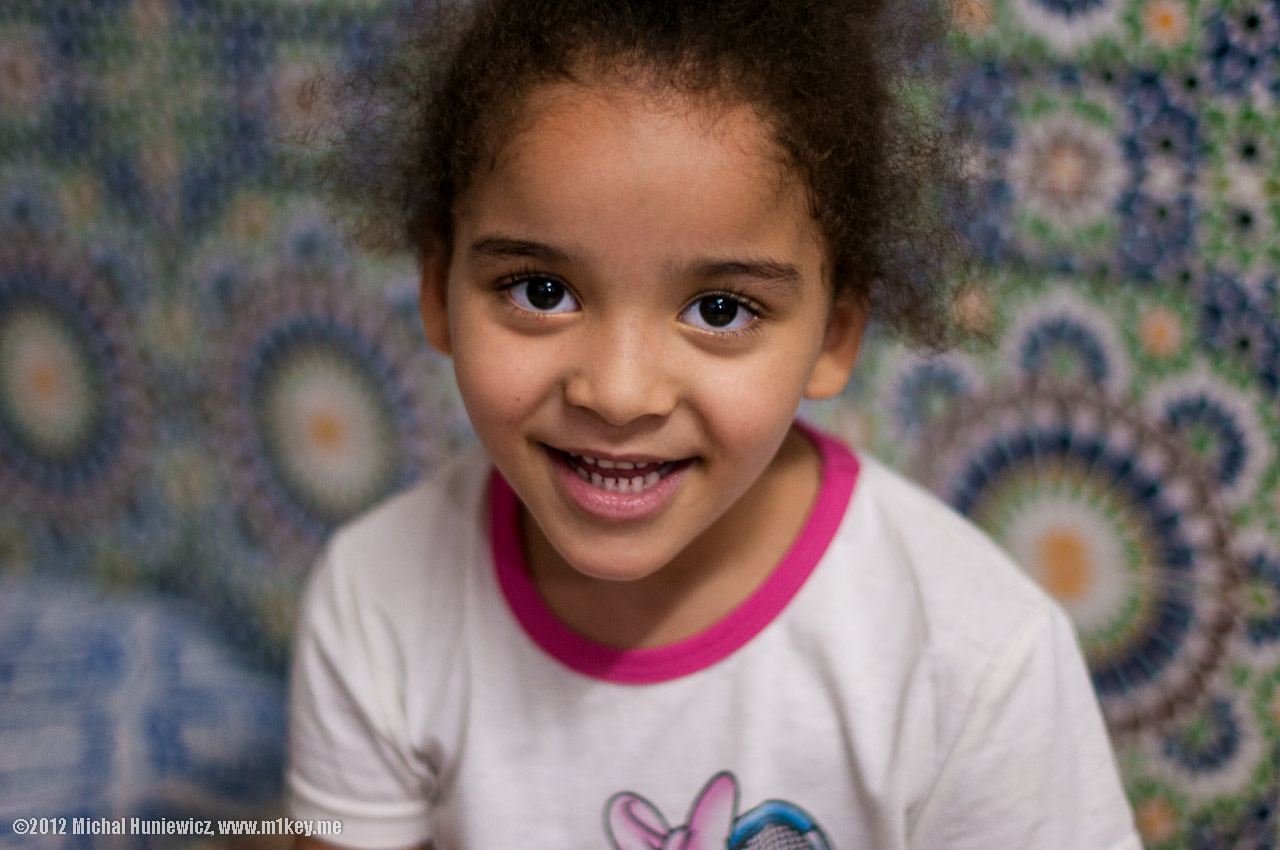
This girl really liked me and in the end I gave her my sunglasses as a souvenir - after all, I won't need them in England!
ISO 200, 50 mm, f/1.4, 1/125 s.
Offer

They even offered me their daughter as a wife; not the first time in Africa that this happens to me! (true story)
Here, she is being presented in an analog picture from a photo album they brought, in her best clothes, I suppose. Of course, not only could I see her in the flesh, but also they had the rings ready!
Here, she is being presented in an analog picture from a photo album they brought, in her best clothes, I suppose. Of course, not only could I see her in the flesh, but also they had the rings ready!
ISO 200, 50 mm, f/1.4, 1/100 s.
View

The view from Fort Bourdonneau, according to Wikimapia, which has become someone's household, by the looks of it;
this is also where I was almost attacked by a angry dog that was on a long lead attached to something;
I just didn't know how long the lead was! Well, it wasn't long enough, but still I burnt around 500 calories entering the holy-guacamole-run-away mode
evolution equipped me with, for 1 second.
After that I was yelled at in French (not by the dog).
ISO 200, 22 mm, f/10, 1/125 s.
Four women and a boy

I had a chat with the first woman from the left, in Dutch! Turned out she lived somewhere in the Netherlands. In fact, the woman on the right has an
Albert Heijn bag - that's a Dutch supermarket chain I had a loyalty card for (man, the cookies you could buy there...). For some reason, they wanted
my postal address in England. They warned us not to hang around there for too long, telling us it wasn't safe, but in our experience it was.
ISO 200, 18 mm, f/5.6, 1/400 s.
Rubbish

The reality of Morocco - beautiful nature vs. rubbish, and no one seems to care.
The mountain is called Jbel Zalagh, and there are TV and radio stations on it.
The mountain is called Jbel Zalagh, and there are TV and radio stations on it.
ISO 200, 18 mm, f/13, 1/80 s.
Meditation
King

Just like in Jordan (or in Tunisia, before the revolution that is), the beloved leader's photos are everywhere, on stamps, bank notes,
postcards, paintings, you name it! This one is King of Morocco and his name is Mohammed VI.
He is, apparently, a serious upgrade of his father, King Hassan. People are no longer shot for criticising him, and he has even attempted some reforms, although probably due to the Arab Spring pressure. There is no real chance of Morocco becoming a proper democracy any time soon, as the political parties are weak, and the king remains especially popular among the poor and illiterate Moroccans thanks to propaganda and populist acts of good will. [12]
He is, apparently, a serious upgrade of his father, King Hassan. People are no longer shot for criticising him, and he has even attempted some reforms, although probably due to the Arab Spring pressure. There is no real chance of Morocco becoming a proper democracy any time soon, as the political parties are weak, and the king remains especially popular among the poor and illiterate Moroccans thanks to propaganda and populist acts of good will. [12]
ISO 100, 120 mm, f/5.3, 1/250 s.
Hello!

They're called Barbary apes, but are in fact tail-less monkeys (I thought monkeys with no tails were apes by definition?).
Their proper name is Barbary macaques, and, besides humans, they are the only primates living freely in Europe (in Gibraltar). [11]
ISO 200, 50 mm, f/1.4, 1/800 s.
Careful now

One of them peed on me from the tree (true story). I was told it was good luck.
ISO 400, 50 mm, f/1.4, 1/2000 s.
Eyes

It's incredible how human they were! The way they look at you, or take food from your hand...
ISO 450, 135 mm, f/5.6, 1/200 s.
Almost sunset

Bye bye, African sun.
(Yes, this is one of the sneaky ones.)
(Yes, this is one of the sneaky ones.)
ISO 200, 18 mm, f/10, 1/160 s.






